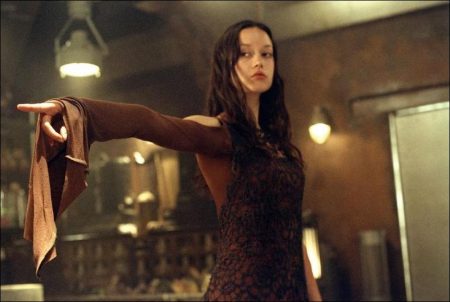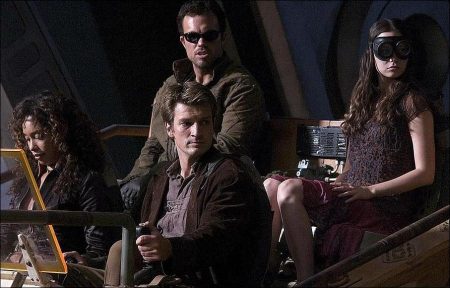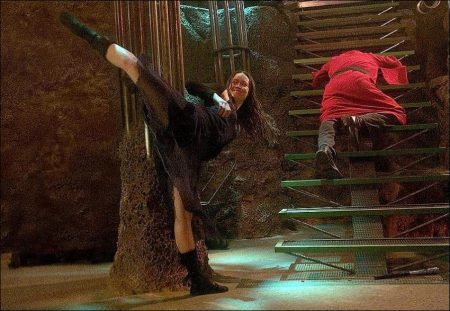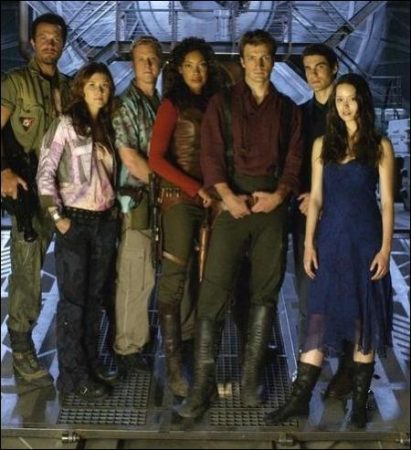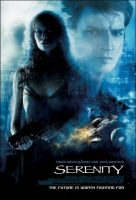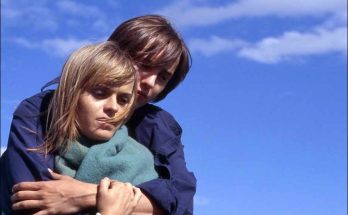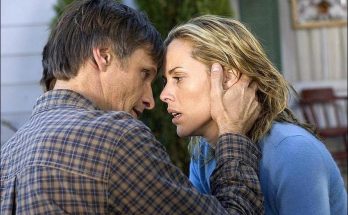Tagline: The future is worth fighting for.
Serenity movie storyline. Joss Whedon – the Oscar- and Emmy-nominated writer/director behind the global phenomena of Buffy the Vampire Slayer and Angel-makes his feature film directorial debut with the science-fiction western adventure Serenity.
The film is based on Whedon’s critically acclaimed, short-lived television series Firefly, which aired on the FOX TV Network during the fall of 2002. Set in a futuristic, post-Earth universe dominated by a planetary Alliance, the series chronicled the adventures of the ragtag spaceship Serenity and her eclectic crew of outcasts, led by Captain Malcolm “Mal” Reynolds, played by Nathan Fillion.
Although FOX TV cancelled the show after only 11 of the 14 produced episodes had aired, Firefly’s quirky mix of humor, complex characters and sci-fi had attracted a loyal and passionate following. The heartbroken fans, the cast and Whedon wouldn’t allow the cancellation of the series to equal the end of this universe. For Whedon, “this story was not done being told. It wasn’t out of me yet…and it wasn’t out of these actors.” While efforts to find a new home for the series on another network or cable channel proved fruitless, all parties were nonetheless determined to keep the campaign alive.
Lobbying for the release of the series on DVD, they saw the Firefly fan base multiply dramatically after the episodes went on sale-almost exactly one year after the last airing on FOX. Once on shelves, the sales of Firefly resoundingly expressed both the loyalty of the fans and the potential for creating new ones. Still, as much as they refused to give up the good fight, everyone invested in the series knew it would take a miracle to see their beloved show resurrected.
They got their miracle in early 2004. Universal Pictures, excited to work with Whedon and impressed by the afterlife of the show saw an opportunity to fill an impending void for sci-fi enthusiasts facing the end of the Star Wars and Star Trek sagas. The studio agreed to develop a feature film based on the Firefly series-to be written and directed by Whedon The film, titled Serenity, would be both a hybrid of the continued adventures of the Serenity crew and a story that would engage moviegoers who had no exposure to Firefly.
While some industry analysts and the media were perplexed by the notion of a theatrical movie based on a failed television series, Firefly fans-or “Browncoats,” named after the series’ anti-Alliance underdog freedom fighters-were ecstatic. They mobilized their efforts to make sure the studio would follow through, greenlight the project and give it the full marketing support it needed to succeed as a major motion picture.
Firefly: A Beacon of Hope
Whedon’s ability to create a self-contained universe stocked with compelling characters, unexpected humor and imaginative stories has resulted in a myriad of projects during his career. In addition to creating and executive producing the television series Buffy the Vampire Slayer and Angel (as well as writing and directing multiple episodes of each), he has brought his trademark wit and compassion as a writer to films such as Speed, Alien: Resurrection and Toy Story, for which he received an Academy Award nomination.
Whedon conceived of the television series Firefly after reading Michael Shaara’s Civil War novel, “The Killer Angels.” The appeal of post-war survivors scraping by on the outskirts of society-in a science-fiction context-struck a chord with Whedon. “I was taken with the idea of a civil war and rebuilding from the point of view of people who had lost the war,” he says. “There were people after the war who internalized it so terribly that it completely destroyed them.”
Starting by dreaming up the different characters, Whedon then wove a humanistic tale set in a frontier world of planets instead of plains. “I wanted to tell a story about people who were living in space, but not living in grandeur,” he describes.
“We’ve used up the Earth, so we’ve moved on to a new solar system,” he continues. “Where once we had new countries to explore, now we have planets. There’s no alien life of any kind that we have discovered. It’s still just us. It’s a vision of the world more or less as it is today.”
“The idea of the show was that in the future, nothing has changed,” Whedon notes. “We’ve got more technology. We’ve got more people. But we’ve got the exact same problems: personally, politically and ethically.”
In this world we find Mal (Nathan Fillion), a soldier on the losing side of a galactic civil war, who now ekes out a living pulling off small crimes and captaining the transport-for-hire ship Serenity. He leads a small crew who are the closest thing he has left to family: his second-in-command Zoe (Gina Torres); Zoe’s pilot husband Wash (Alan Tudyk); the mercenary Jayne (Adam Baldwin) and ship’s mechanic Kaylee (Jewel Staite) who together provide Mal the opinionated, insubordinate and ultimately loyal mates he needs to survive in the outlands.
Threatening their survival are two of the most formidable enemies: first, the establishment known as the Universal Alliance (those on the winning side of the war); and second, the horrific, cannibalistic Reavers-savages who roam the edges of space. The crew find themselves trapped between the Alliance, who seeks to bring order-wanted or unwanted by their subjects-to these various planets, and the Reavers, who seek wanton chaos and destruction.
Further complicating matters for Mal are the beautiful courtesan Inara (Morena Baccarin), a woman who alternately inspires and infuriates him; Shepherd Book (Ron Glass), a preacher who challenges Mal to the fullest; and two mysterious passengers: the young doctor Simon (Sean Maher) and his unstable, telepathic sister River (Summer Glau). Her talents long-used by the Alliance, she possesses dangerous secrets buried so deeply, even she doesn’t know what they are.
The series garnered acclaim from critics and a burgeoning fanbase, but Firefly nonetheless lasted only 11 episodes before leaving the air, a casualty of its frequently pre-empted time slot and the show’s own hard-to-pigeon hole tone and content.
“Everyone had gelled together into a big family,” remembers Serenity Executive Producer Christopher Buchanan. “We were very fortunate in that way. But when the show was cancelled, it was a real gut shot to everyone involved.”
But Whedon chose to see it merely as a postponement rather than an end. He vowed to his Firefly cast and crew that he wouldn’t rest until he found a new home for the project. “I actually wrote Christmas letters to all nine of them letting them know where I was in my progress, and they kept me informed if they were going to do something,” Whedon says. “I just believed so strongly in these characters, and particularly in these actors, that I refused to believe that the show had been cancelled. I went into a severe state of denial.”
As the series’ set was being dismantled, cast member Alan Tudyk salvaged a prop for Whedon from a pivotal episode. “The ship is dying and the only chance the crew has is to take off in other ships and try to find help, leaving Mal behind,” describes Tudyk. “In this episode, Wash installs this special button and says, `When your miracle gets here, pound this button one time and it’ll bring us all back.’
“I still have that button in my office,” Whedon says fondly. Whedon’s faith in keeping Firefly alive was infectious. “Every time I’d be about to give up, one of the actors would just call and say, `we’re still waiting. We still believe,’” he remembers.
Once a Browncoat…
Whedon’s fans from his days of Buffy and Angel had long known that he tended not to accept defeat. In 1992, Whedon wrote the original screenplay for the feature film version of Buffy the Vampire Slayer, only to see its essential elements changed drastically for the film. He then adapted it for television-turning it into one of the most successful series of all time. He does not give up easily. And neither do his devoted fans. An online campaign, coupled with strong DVD sales and support from critics, provided just the ammunition Whedon needed to bring his vision to the masses. Browncoats identified with the daily struggles of the Firefly crew-misfits who refused to be assimilated into an Alliance-ruled universe.
Online portals for fans of the show were deluged with cries to bring Firefly back. Hopeful fan mail reached studio executives. Advertisements were taken out in Variety to keep the show alive. Browncoats who had found a home on this battered cargo ship were showing their collective muscle. And someone was paying attention…
Serenity Takes Flight
The rebirth came when Whedon and producer Barry Mendel (The Sixth Sense, The Royal Tenenbaums) took the idea for a feature film to Mary Parent, who at the time was vice chairman of worldwide production for Universal Pictures. “A lot of people have asked how hard it was to convince the studio to do this, and it’s weird…it wasn’t that way at all,” explains Mendel. “Mary was a fan of Joss and kept in touch with him and with me. And to Universal’s credit, they understood that Joss had a passion to do this.”
The studio believed in both Whedon’s vision and this story and purchased the rights to make a major motion picture out of his unique television series. Firefly’s loyal and active international fan base of Browncoats rejoiced. “These people are mad with passion for the things they like,” comments Fillion. “And Joss has an easy way of getting them invested in the characters and the relationships between them.”
The film’s greenlight presented a whole new challenge for Whedon. He shares, “To make all these people and these different worlds come to life with the kind of shorthand that you use in a movie…I needed to give them a story epic enough that it’s not just another episode in these character’s lives, but a journey that will change them forever.”
Two-hundred-odd pages later, Whedon had a draft of what would become Serenity’s script-what he called the Kitchen Sink version-which he then whittled down to a manageable, filmable length. “When it comes to the bells and whistles, yes, we have them all: a hovercraft, action, gunfights, fistfights, cannibals-everything you could want in a movie,” he says. But more important to him was to fully explore the untapped potential of this crew and this story…potential that could only be realized with a feature-length film.
He decided to revolve much of the action of the film around the mysterious character of River Tam, the child prodigy taken by the Alliance and experimented on for unrevealed purposes-until she’s rescued by her brother and smuggled aboard Serenity. The Alliance dispatches a deadly Operative who will stop at nothing to reclaim the girl. When, seemingly out of nowhere, River starts attacking everyone in a crowded cantina with the prowess of a trained assassin, Mal and his crew begin to realize that a danger greater to them than either the Alliance or the Reavers may be on board Serenity herself.
“The TV show had nine characters, all of who appear in the film,” Whedon says. “Although you could say Mal is the hero, everybody in it is the hero of their own story, and they’re all equally important to me. More than anything, the movie should leave audiences feeling like they’ve just been through something with people they care about. We have nine people aboard a small transport ship who live on the edges of space, who do the sort of work that is not generally done in science-fiction movies: the odd jobs, the dirty jobs. I love this crew-they’re extraordinary characters. Best of all for me is that the people who play them are also extraordinary actors, extraordinary human beings, and I’m incredibly fortunate to be working with them again.”
Although the cast had all stayed in touch after Firefly ended, reuniting for the script read-through was an emotional experience for all of them. “A lot of these guys I see constantly, but having them play the characters was like seeing friends I hadn’t seen in a long time,” comments Fillion.
“Joss said that he wasn’t done yet,” recalls Glass. “He said not to be surprised if we were all gathered together again in some other place, or in some other expression.”
Baldwin describes Whedon as “a hero, because this project needed to continue, and here we are.”
In addition to the nine characters returning from the series, there were a few key roles that would need to be filled by newcomers to the group, most importantly the role of The Operative. Whedon “wanted the Alliance to be a presence that was truly threatening to our characters.” He continues, “I wanted The Operative to be somebody who was noble and decent and kind, yet still creeped the hell out of you.” Whedon cast Chiwetel Ejiofor, who garnered rave reviews for his performance in the acclaimed independent film Dirty, Pretty Things and was part of this summer’s hit drama Four Brothers. Whedon notes, “Chiwetel managed to completely internalize The Operative and make him somebody very real. Decent, thoughtful and a mass murderer.”
Completing the principal cast was the addition of David Krumholtz (CBS’s Numb3rs) as Mr. Universe, the mysterious man who holds the galaxy’s entire communications network at his fingertips.
Can’t Stop the Signal: Browncoats Unite
Even before filming began, all agreed that it was mandatory to involve the eager Firefly fans in every step of the process. In July 2004-only one month after principal filming began-Whedon and the cast appeared at the annual Comic-Con fan convention in San Diego, where they (and very early film footage) received a thunderous reception from the 5,000-plus people in attendance.
In December 2004, merely months after filming wrapped, Universal Pictures executives were unprepared for what they encountered at a blind-recruited audience sneak preview. Somehow, the word got out to the Browncoats that there would be a showing of Serenity, and they packed the theater. Experiencing the film with 300 wildly enthusiastic fans, who-despite the fact that the print was extremely rough-laughed, cheered and applauded every beat prompted the studio to rethink their release plans for the film. Browncoat Denise Gribe, a 40-year-old from Silverlake, California, summed up the feelings of the audience when she noted, “I feel like the fans made this possible. Cowboys in space with guns…speaking Chinese. It’s our little show on the big screen!”
The opening date was moved from Spring to Fall 2005 to allow more time for both post-production and further innovative marketing of the film. The release was now slated for September 30, 2005. To offset any disappointment the fans might feel at having to wait another six months for the film, the filmmakers and studio execs devised a thorough outreach plan to reward the Browncoats for their loyalty and tenacity…and keep them invested in the campaign.
First, Whedon and the cast appeared at the Wonder-Con and Wizard-Con fan conventions in early 2005, where they treated the audiences to early sneak peaks at unfinished extended sequences from the film. Then in late April, Whedon posted an online invitation for Browncoats to attend a special paid-preview screening of the work-in-progress-scheduled for Thursday, May 6th in 10 cities nationwide. He directed fans to web sites where they could purchase advance seats. In the trademark Whedon way, he wrote to the fans, “When I whined on about pushing the date and everyone here was posting about `what do we do till September?’ the studio agreed to let me sneak it out.”
These screenings sold out in a matter of hours. Some Browncoats traveled from out of state, and a fraternity even chartered a bus for its members to travel for the showing. Tickets were being sold on eBay for $300 each. Some people showed up a day early and spent the night camping out on the sidewalk in front of the theaters, though they already had tickets in hand. Whedon and the cast made live appearances in five of the cities, and the writer-director taped a special direct-to-audience message introducing the film at the screenings, transcribed below:
Hi I’m Joss Whedon. Before we begin this special screening, I have a little story I want to tell you. It’s about a TV show called Firefly. Firefly went on the air a few years ago and was instantly hailed by critics as one of the most cancelled shows of the year. It was ignored and abandoned, and the story should end there. But it doesn’t, because the people who made the show and the people who saw the show-which is roughly the same number of people-fell in love with it a little bit too much to let it go, too much to lay down arms when the battle looked pretty much lost.
In Hollywood, people like that are called unrealistic, quixotic, obsessive. In my world, they’re called Browncoats. Now whether you watched the show on TV or saw the DVDs-or whether you never set foot in the Firefly universe before tonight-the fact that you’re here means that you’re part of something, something that is a little bit remarkable. This movie should not exist. Failed TV shows don’t get made into major motion pictures-unless the creator, the cast and the fans believe beyond reason. That’s what I have felt, and that’s what I have seen in the DVD sales, the booths at the cons run by fans, the web sites and the fundraisers-all the work the fans have done helped make this movie.
It is, in an unprecedented sense, your movie. Which means…if it sucks, it’s your fault. You blew it. You let us down. But let’s not dwell on your failures, because the work is not done. I have to finish making it. This is not quite a final cut, and you’ll notice some placeholders in music and FX. But we are very close, and once we are finished…you have to get people to see it.
Now obviously the studio will do its thing. There will be ads and trailers and all that joy, but this movie does not have stars. It doesn’t have a giant mega budget. It doesn’t even have a simple saleable premise. What it has is us-the people who believed unreasonably. If this movie matters to you, let somebody know. Let everybody know. Make yourselves heard.
If you don’t like the movie…this is a time for quiet, for months of silent contemplation. But when the unfinished credits roll-if you still call yourself a Browncoat-remember the millions of people who don’t…who might. I want us to do this together. The cast will be appearing wherever they can. I will be blogging and stumping and whatever I can think of. We have CantStoptheSignal.com up and running.
I’m fairly certain we’re all doing everything we can to make this the event it should be. Because remember: they tried to kill us. They did kill us, and here we are. We have done the impossible, and that makes us mighty. Thank you for helping getting this movie as far as it has gotten. Welcome to Serenity.
Due to the overwhelming response, Whedon and the studio added a second wave of these paid-previews for the unfinished film three weeks later on Thursday, May 26th. This time, Serenity was shown in 20 cities-the original 10 plus 10 more. Once again, every seat was gone only a few hours after Whedon posted an online message. A good percentage of attendees were seeing the movie for the second time. Thrilled fans demanded more screenings and promptly swamped filmmakers with emails, phone calls and web postings.
The third time proved just as successful when, four weeks later, on Thursday, June 23rd, the still-unfinished film was previewed to sell-out audiences in 35 cities-the previous 20 plus 15 new ones. Browncoat Clayton Dilts, 28, from southern California proudly requested of Whedon, “Fight tooth and nail and give me more!”
In addition to the die-hard fans, the second and third wave screenings found new recruits and those curious about the phenomenon filling the seats. These grassroots events started generating press coverage in local market papers and quickly garnered national publicity in publications such as Entertainment Weekly, Wired and The Hollywood Reporter.
When they returned to Comic-Con this past July, Whedon and the Serenity cast received a standing ovation from the 6,500 fans. The entire convention buzzed with excitement and anticipation about the world premiere of the finished film. Two hundred Browncoats were given the opportunity to attend the screening, with Whedon personally introducing the film and then answering questions and signing autographs afterwards. Finishing touches included composer David Newman’s haunting score. The San Diego crowd was simply thrilled at the film’s viewing. Newman’s choices prompted chills from audience members and Joss to share, “He gave me my space western, my multi-cultural mishmash. I may have designed Serenity, but it’s David Newman that made her soar.”
On August 22, 2005 Serenity made her maiden voyage at the worldwide premiere in Scotland at the Edinburgh Film Festival. The capacity crowd leapt to its feet when Joss and crew came on stage. With gushing reviews in the festival trades, extremely high audience ratings and industry insiders full of praise, there seemed to be no stopping her flight.
The attendees at Comic-Con and in Edinburgh, fans of Firefly, newcomers through the DVD experience and those coming to the film fresh had one thing in common. They felt they were seeing characters they cared about in a compelling, entertaining story-something they hadn’t seen in a science-fiction film for a long time. Not only was the core Serenity community celebrating, but the new fans were joining in to watch her fly.
In Depth: The World of Serenity: Serenity’s Crew and Passengers
(2507 A.D.) Five hundred years in the future, Earth-That-Was is no longer habitable and mankind has colonized a distant galaxy. The Central Planets within this new solar system are bound by one law, one Alliance. “For every good action there is a reaction, and the forming of the Alliance does not create an evil empire or a totalitarian state,” comments Whedon, “but a power so great that there’s no way it can justly rule over the entire universe. Whenever you create some kind of utopia, you find ugly working underneath it.”
Captain Mal Reynolds (Nathan Fillion) was one of the holdouts on the losing side of the great War for Unification, where the Alliance sought to bring the outer rim planets under its control. “Mal is someone who fought at a time when he was just crushed by the opposing force,” says Whedon. “There was no way he was going to be able to stop the tide of history. And the experience changed him.”
“He’s not an evil man,” finds Whedon. “He hasn’t lost his moral compass completely. He has just given up on the idea of the decency of human nature. Or that anything is worth fighting for, except the next meal and the people around him.” Fillion adds, “As empty as he is, as hard as he is, he desperately clings to and protects what makes him whole, which is the ship and everyone on it.”
His second-in-command, Zoe Alleyne (Gina Torres), fought by Mal’s side in more than a dozen campaigns, including their planet’s final battle for independence against the Alliance. She was the only other member of the 57th to survive the bloody fight for Serenity Valley. Zoe’s husband, Hoban Washburn-Wash-(Alan Tudyk), is her opposite: a good-natured pilot who loves to fly but hates to fight. “Zoe’s great passion is keeping this ship from falling into oblivion,” says Torres. “She’s a career soldier and is completely loyal to Mal, which sometimes causes friction with her husband.”
“Zoe’s a killer…and that’s far from who Wash is,” Tudyk explains. “He just wants to fly the ship, make some money. And then, once they get some money, he wants to go on a vacation. He doesn’t love the crime, but his pilot skills come in handy when he has to be the getaway driver.”
Kaylee (Jewel Staite), a scrappy farm-girl with a genius for machines, is the ship’s engineer and mechanic. “Kaylee is really the soul of the ship,” describes Whedon. “She believes that life is decent. She loves machines. She loves being on that ship, keeping it running. She thinks that’s a great life.” Explains Staite, “There are so many beautiful, more high tech ships out there with lots more gizmos. But Fireflies are special because they’re fast; they maneuver easily; and they have all kinds of hidden compartments for smuggling things. It’s like a vintage car…it’s kind of junky; it breaks down every other week, but you keep repairing it.”
Where Kaylee is all heart, mercenary fighter Jayne Cobb (Adam Baldwin) is all muscle. “Jayne is big and self-interested,” says Whedon. “He’s not from the war. He shoots people because he gets paid. He is not somebody you necessarily want at your back in a firefight because if the other guy’s paying more, he might be a little closer to your back than you want.”
In their travels across planets both primitive and civilized, the crew runs under the radar, as far from the enforced order of the Alliance as the ship and a succession of small-time heists can take them. Their freedom comes at the price of, “not having food, being broke, having things fall apart on the ship,” explains Alan Tudyk. But unbeknownst to them, their fate becomes inextricably tied to the addition of the ship’s two newest passengers. Simon Tam (Sean Maher), a young doctor and his unstable sister, River (Summer Glau).
“Malcolm Reynolds and his band of renegades have taken in a young girl and her brother who are not everything they appear to be,” says Whedon. “They’re on the run from the Alliance, and Mal tends to do things to piss them off when he can. But this helpless young girl he has taken on board turns out to be both not that helpless and possibly not that great a choice for a passenger.”
A natural telepath, River spent years subjected to experiments in an Alliance lab that left her forever altered, possibly even dangerous. They have unknowingly exposed her to the dark secret that keeps the order the Alliance seeks to uphold. “She is filled with secrets she’d rather not know…because even the best of societies have ways of keeping themselves powerful,” comments Whedon.
The Players in Serenity’s Universe
The Alliance has dispatched a skilled and deadly Operative to reclaim River-and the secrets locked in her damaged psyche. The Operative believes his mission is to protect the Alliance at all costs, which makes him far more dangerous than a paid assassin. “The Operative thinks of himself as an instrument,” feels Whedon. “The idea that he doesn’t have a name becomes to me something that is both creepy and weirdly ennobling.”
When he kills it’s with a sense of purpose. “His mission is to create a world where nobody is mean, where nothing bad happens,” says Whedon. “He sees what evil is, and he hates it. He knows that he does evil, yet he allows himself to step outside of his own moral structure so that he can accomplish what he needs to accomplish, which has made him something less than human. And that is both weird and sick and kind of beautiful.”
The Operative’s promise to the Alliance is that no matter how far and fast the crew of Serenity flies, he will find a way to flush them out and retrieve River. Not a simple task, Ejiofor explains. “The Operative realizes something about Mal, which is that he’s not capable of backing down.”
Whedon explains, “River exposes all the rifts within the crew, and the holes in the ship…as it were…because she brings the weight of the Alliance down on them in the form of The Operative, and also because she is unknowingly an agent of the Alliance-a weapon of theirs-and could basically kill everybody on board if they decided to make her. And so Mal has, in his own way, put them in the exact kind of danger he’s been looking to avoid for the last few years.”
Mal’s resistance to the Alliance and the manhunt by The Operative have put his friends in jeopardy. The Captain still harbors deep affections for a beautiful Companion named Inara Serra (Morena Baccarin), whom The Operative uses to lure Mal out into the open. “A Companion is essentially a futuristic geisha,” explains Baccarin. “They live in a time in which prostitution is legal and it’s seen as a classy profession because of the trade, because of what they learn and what they know. Inara has learned many different languages and dances and archery. She can fight and at the same time is very sophisticated.”
“You see Inara and her sophistication, and right away you know why she and Mal have never been able to get together,” says Whedon. “They’re both strong-willed, completely different and perfect for each other.”
Two other remnants of Mal’s checkered past provide him with guidance. Shepherd Book (Ron Glass) is a man of faith with mysterious knowledge of the Alliance and the ways of The Operative. Rounding out the cast, Mr. Universe (David Krumholtz), monitors the signals that race across the galaxy from a remote hideout he shares with his female “lovebot.”
Even greater dangers await Serenity’s crew on the outer limbs of the solar systems-Reavers, vicious creatures that haunt the edges of space. “On one side we have the Alliance, embodied by The Operative, who is utterly intractable morally and will kill anybody,” describes Whedon. “On the other side, we have the Reavers.”
“If you encounter a Reaver, that’s it,” shares Fillion. “You’re done for. That’s how bad they are. They don’t want to kill you; they want to kill you slow. They want to eat you; they want to skin you. There’s just no end to their evil.”
“Their mind is so far gone that they don’t realize the violence they do-it’s just their way of life,” adds Staite. “In that way, they’re scarier than monsters or aliens because there’s a human being underneath all that insanity.”
But the real threat to the crew may be aboard the Serenity herself. “Mal’s whole motivation is just to survive the day, and here comes this kid that he has no connection to at all, whom he has no reason to care about,” says Glau. “If anything, he needs to get her out of his life because she’s only going to cause trouble. And somehow he just can’t do it.”
Beset from all sides, Mal’s choice is to give up his troubled, possibly deadly passenger or to take a stand and pursue the secret the Alliance is fighting so hard to protect. “For all of them, it’s about freedom,” Whedon says. “This movie is really about Mal discovering if there is in fact something worth believing in and something worth fighting for again.”
Visualizing Life on Distant Worlds
When Universal greenlit the film, everyone involved understood that it had to be made for a reasonable price. Producer Barry Mendel describes Serenity as an “underdog movie. We’re lean and mean,” he says. “There’s no bloat on this movie. They gave us a certain amount of money and said, `be ingenious, be smart…figure it out.’”
For his feature directorial debut, Whedon chose to populate his crew with a mix of trusted longtime collaborators and some of the big screen’s most sought-after, behind-the-scenes craftsmen. Film editor Lisa Lassek had teamed with him on a number of episodes of Buffy. A natural fit for Whedon, he brags, “She can work an Avid like Vladimir Horowitz.”
Having often used several of Clint Eastwood’s films to describe the physical and emotional terrain of Serenity, Whedon jumped at the opportunity to work with Oscar-nominated director of photography Jack Green ASC, who shot Eastwood’s Unforgiven, The Bridges of Madison County and Bird, among others.
“Everything had to be a little bit grander for the film,” says Whedon. “We had to amp up everything we had done to a much greater scale. I wanted desperately for this to be wide screen, because it’s a drama with a large cast, it’s a space epic and a bit of a western. All of that just cried out for wide screen. But you need to put something in that’s epic in scale.”
To design the universe of Serenity, the filmmakers brought on production designer Barry Chusid, who previously oversaw Earth’s destruction in the 2004 blockbuster The Day After Tomorrow. His primary task would be to incorporate and maintain a feel that fans of the show would instantly recognize while crafting a world that could capture the imagination of people who had never been there before.
Executive Producer Alisa Tager comments, “Barry made everything so much more rich and more textured. He did an amazing job establishing the ship-the one thing that had to be nearly exact. Anybody who knew it from the show was going to recognize it immediately. When the cast came on, they had an immediate emotional reaction…a feeling that they were back home again.”
Chusid built Serenity’s interiors on soundstages on Universal’s sprawling back lot. He fit many of the sets with removable walls to create an all-encompassing environment that could be manipulated to accommodate Whedon’s vision for a lengthy opening sequence. He felt it vital to introduce the audience to Serenity by taking viewers through the whole of the ship in one continuous take.
Whedon’s mandate to Chusid and all the production heads was to make his imagined world, in which both Chinese and American cultures are dominant, utterly realistic. “This future is unlike the future that we normally assume,” comments the film’s costume designer, two-time Academy Award nominee Ruth Carter (Amistad, Malcolm X), who sought to reference visual themes from the series but find new ways to express them. “I think we assume it’s something in the Matrix-y vein, where everything is completely original and new. But I think this sci-fi hearkens back to civilizations that deteriorated, as well as those worlds and cultures that advanced.”
Serenity (2005)
Directed by: Joss Whedon
Starring: Nathan Fillion, Gina Torres, Alan Tudyk, Morena Baccarin, Adam Baldwin, Jewel Staite, Sean Maher, Summer Glau, Sarah Paulson, Chiwetel Ejiofor, David Krumholtz
Screenplay by: Joss Whedon
Production Design by: Barry Chusid
Cinematography by: Jack N. Green
Film Editing by: Lisa Lassek
Costume Design by: Ruth E. Carter
Set Decoration by: Larry Dias, Jim Johnson
Art Direction by: Daniel T. Dorrance
Music by: David Newman
MPAA Rating: PG-13 for sequences of intense violence, action, sexual references.
Distributed by: Universal Pictures
Release Date: September 30, 2005
Views: 66
